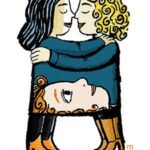Is your dog suddenly showing signs of imbalance, head tilt, or circling? It can be alarming to witness these symptoms. While it might seem like a stroke, your dog could be experiencing idiopathic vestibular disease. This guide will provide comprehensive information on this condition, focusing on how to help your dog recover.
A comforting hand for a dog experiencing vestibular symptoms, illustrating the importance of supportive care.
Understanding Idiopathic Vestibular Disease in Dogs
Vestibular disease affects a dog’s balance by disrupting the inner ear and brain’s sense of spatial orientation. Imagine the feeling of extreme vertigo – that’s similar to what your dog experiences. They may feel like they’re falling, even when still.
The term “idiopathic” means the exact cause is unknown. While frightening, the good news is that with supportive care, including proper nutrition and a comfortable environment, many dogs recover well.
Symptoms to Watch For
If you notice any combination of these signs, consult your veterinarian immediately:
- Leaning to one side
- Head tilt
- Ataxia (wobbly and uncoordinated gait)
- Circling
- Nystagmus (eyes flicking back and forth or up and down)
- Wide-legged stance
- Vomiting
A German Shepherd exhibiting a head tilt, a common symptom of canine vestibular disease.
Potential Causes of Vestibular Disease
While often idiopathic, vestibular disease in dogs can sometimes be linked to:
- Ear infections
- Cancer
- Vascular events
- Drug toxicities
- Inflammatory diseases
- Hypothyroidism
Veterinary diagnosis is crucial to rule out underlying causes and determine the best course of action.
A veterinarian examines a Dachshund, highlighting the importance of professional diagnosis in determining the cause of vestibular issues.
Supporting Your Dog’s Recovery: Feeding and Care Tips
One of the biggest challenges with vestibular disease is ensuring your dog gets adequate nutrition. The dizziness and nausea can make eating difficult. Here’s how you can help:
1. Provide a Supportive Environment
- When Lying Down: Support your dog with pillows, blankets, or a bolstered bed. Creating a secure and stable position can reduce the sensation of spinning.
A Mastiff mix supported by pillows, demonstrating how to create a safe and comfortable resting space for dogs with balance issues.
- When Standing: As your dog improves, offer support while standing. Position food and water bowls at chest height in a corner, allowing them to lean against the wall.
2. Enhance Traction and Stability
- Ensure your dog is on a non-slip surface. Yoga mats and rubber-backed rugs can be helpful.
- Consider using Dr. Buzby’s ToeGrips® dog nail grips to improve traction and proprioception. These grips can boost confidence and stability.
3. Make Food Appealing
- Moisten your dog’s regular food with warm water or low-sodium chicken broth to make it easier to chew and more palatable.
- Form canned food into “meatballs” for easy hand-feeding, especially in the initial stages.
- Be patient! Dropping food is common. Simply pick it up and offer it again.
A Yellow Lab being fed kibble, illustrating how proper nutrition and assistance can aid dogs during recovery.
4. Medications for Symptom Management
Your veterinarian may prescribe medications to manage nausea and other symptoms:
- Meclizine: An antihistamine that can suppress vestibular system stimulation.
- Maropitant (Cerenia®): A strong anti-nausea medication with anti-inflammatory effects.
- Ondansetron (Zofran®): A serotonin antagonist to combat nausea.
- Other medications: Anti-inflammatories, antibiotics, steroids, or appetite stimulants may be prescribed depending on the underlying cause and your dog’s condition.
- Consider physical therapy: There are several exercises for dogs with vestibular disease that can aid your dog’s recovery.
A French Bulldog with a head tilt resting in the grass, showing that dogs can recover from vestibular issues with appropriate care.
Recovery and Prognosis
Most dogs recover from vestibular disease, often with only a slight head tilt as a lasting effect. Improvement is usually seen within three to seven days.
If symptoms worsen or your dog refuses to eat or drink, contact your vet immediately. They may recommend fluids or a temporary feeding tube.
You Are Vital to Your Dog’s Recovery
Watching your dog struggle with vestibular disease can be disheartening. However, your role in providing supportive care is crucial. With patience, love, and the right strategies, you can help your dog regain their balance and enjoy a happy, healthy life.

